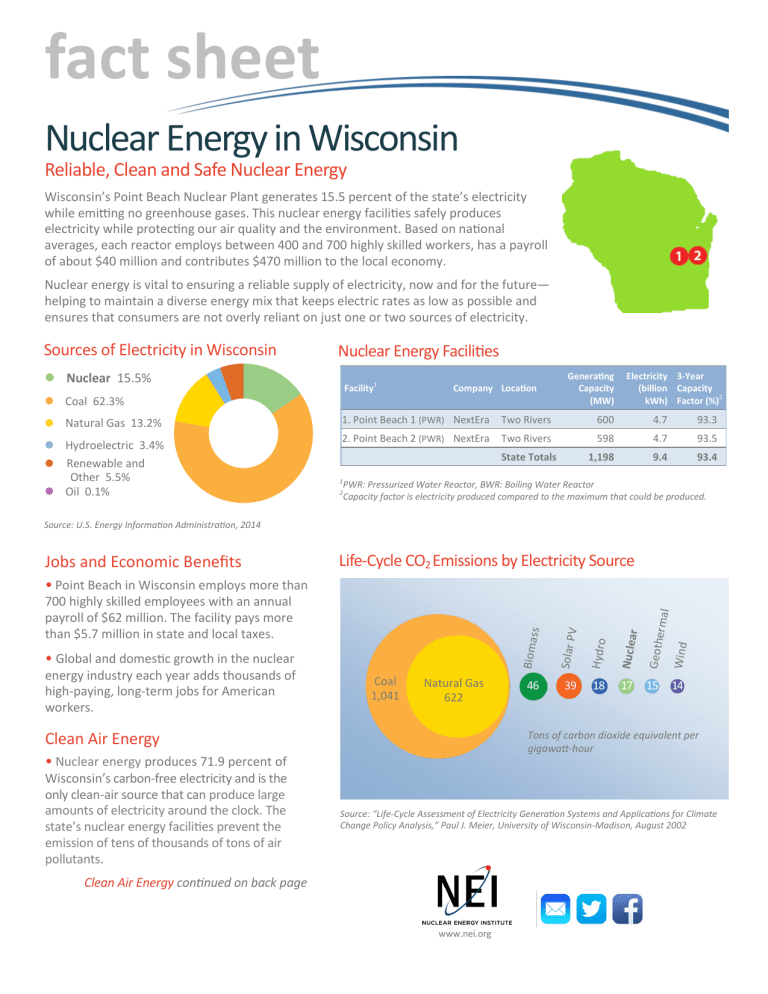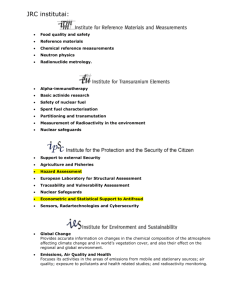Sources of Electricity in Wisconsin

fact sheet
Nuclear Energy in Wisconsin
Reliable, Clean and Safe Nuclear Energy
Wisconsin’s Point Beach Nuclear Plant generates 15.5 percent of the state’s electricity while emitting no greenhouse gases. This nuclear energy facilities safely produces electricity while protecting our air quality and the environment. Based on national averages, each reactor employs between 400 and 700 highly skilled workers, has a payroll of about $40 million and contributes $470 million to the local economy.
Nuclear energy is vital to ensuring a reliable supply of electricity, now and for the future— helping to maintain a diverse energy mix that keeps electric rates as low as possible and ensures that consumers are not overly reliant on just one or two sources of electricity.
Sources of Electricity in Wisconsin
Nuclear 15.5%
Coal 62.3%
Natural Gas 13.2%
Hydroelectric 3.4%
Renewable and
Other 5.5%
Oil 0.1%
Source: U.S. Energy Information Administration, 2014
Nuclear Energy Facilities
Facility 1 Company Location
1. Point Beach 1 (PWR) NextEra Two Rivers
2. Point Beach 2 (PWR) NextEra Two Rivers
State Totals
Generating
Capacity
(MW)
600
598
1,198
Electricity
(billion kWh)
3-Year
Capacity
Factor (%) 2
4.7
4.7
9.4
93.3
93.5
93.4
1
PWR: Pressurized Water Reactor, BWR: Boiling Water Reactor
2
Capacity factor is electricity produced compared to the maximum that could be produced.
Life-Cycle CO
2
Emissions by Electricity Source Jobs and Economic Benefits
• Point Beach in Wisconsin employs more than
700 highly skilled employees with an annual payroll of $62 million. The facility pays more than $5.7 million in state and local taxes.
• Global and domestic growth in the nuclear energy industry each year adds thousands of high-paying, long-term jobs for American workers.
Clean Air Energy
• Nuclear energy produces 71.9 percent of
Wisconsin’s carbon-free electricity and is the only clean-air source that can produce large amounts of electricity around the clock. The state’s nuclear energy facilities prevent the emission of tens of thousands of tons of air pollutants .
Clean Air Energy continued on back page
Coal
1,041
Natural Gas
622 r
PV
N cl u ear
G eo th m er al as s
H yd ro d
Biom Sola Win
46 39 18 17 15 14
Tons of carbon dioxide equivalent per gigawatt-hour
Source: “Life-Cycle Assessment of Electricity Generation Systems and Applications for Climate
Change Policy Analysis,” Paul J. Meier, University of Wisconsin-Madison, August 2002 www.nei.org
Clean Air Energy
continued from front page
• More than 8.8 million metric tons of carbon dioxide are prevented by Wisconsin’s nuclear energy facilities, which equals what would be released in a year by more than 1.9 million passenger cars.
• Numerous studies demonstrate that nuclear energy’s life-cycle greenhouse gas emissions are comparable to renewable energy, such as wind and hydropower, and far less than coal or natural gas-fueled power plants.
• Nuclear energy is an essential element of a lower carbon energy portfolio.
U.S.-Style Reactor Features Multiple Layers of Safety
Emissions Prevented Quantity Prevented in 2014
Sulfur dioxide (SO
2
) 20,206 short tons
Nitrogen oxide (NO x
) 7,428 short tons
Carbon dioxide (CO
2
) 8.8 million metric tons
Used Nuclear Fuel Management
• Nearly 1,460 metric tons of used nuclear fuel are stored at nuclear plant sites in Wisconsin. All of this fuel is safely and securely managed in steel-lined, water-filled concrete pools or in concrete and steel containers, awaiting consolidated storage and disposal by the U.S. Department of Energy.
• As of 2014, Wisconsin has contributed more than
$423.9 million to the federal Nuclear Waste Fund.
Source: Gutherman Technical Services, 2014
Committed to Safety
• America’s 99 nuclear energy facilities are among the safest and most secure industrial facilities. Multiple automatic safety systems, the industry’s commitment to comprehensive safety procedures and stringent federal regulation keep nuclear energy facilities and neighboring communities safe.
• The independent U.S. Nuclear Regulatory Commission regulates and monitors plant performance in three areas: reactor safety, radiation safety and security.
• After more than a half-century of commercial nuclear energy production in the United States and more than 4,000 reactor years of operation , there have been no radiationrelated health effects linked to the operation of nuclear energy facilities. Numerous studies, including those from the
National Cancer Institute and the United Nations Scientific
Committee on the Effects of Atomic Radiation, show that U.S. nuclear power plants effectively protect the public’s health and safety.
• The industry has developed a diverse, flexible mitigation approach (FLEX) to address the major problem encountered at Fukushima: the loss of power to maintain effective cooling.
More than $4 billion of safety enhancements have been made since 2011 to apply lessons learned from the accident in Japan and make U.S. reactors even safer.
Used fuel at nuclear energy facilities is cooled in secure steel-lined concrete pools filled with water.
After the cooling period, nuclear energy facilities store used fuel safely on site in steel and concrete vaults. www.nei.org



